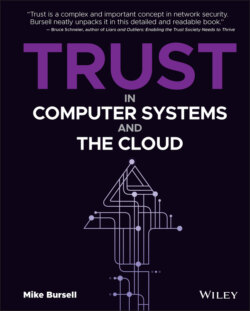Читать книгу Trust in Computer Systems and the Cloud - Mike Bursell - Страница 18
Defining Correctness in System Behaviour
ОглавлениеEarlier, we skirted slightly around the idea of correctness in terms of components and their behaviours, but one way of thinking about security is that it is concerned with maintaining the correctness of the behaviour of your systems in the face of attempts by malicious actors to make them act differently. Whether these malicious actors wish to use your systems to further their own ends—to mine crypto-currency, exfiltrate user data, attack other targets, or host their own content—or to disrupt your business, the outcome is the same: they want to use your systems in ways you did not intend.
To guard against this, you need to know:
How the systems should act
How to recognise when they do not act as expected
How to fix any problem that arises
The first goal is an expression of our trust definition, and the second is about monitoring to ensure that the trust is correctly held. The third—fixing the problem—is about remediation. All three of these goals may seem very obvious, but it is easy to miss that many security breakdowns arise precisely because trust is not explicitly stated and monitored. The key thesis of this book is that without a good understanding of the trust relationships between systems in contexts in which they operate or might operate, it is impossible to understand the possibilities available for malicious compromise (and, indeed, unintentional malfunction). Many attacks involve taking systems and using them in ways—in contexts—not considered by those who designed and/or operate them. A full understanding of trust relationships allows better threat modelling, stronger defences, closer monitoring, and easier remediation when things go wrong, partly because defining contexts where behaviours are defined allows for better consideration of where and how systems should be deployed.
We can state our three aims differently. To keep our systems working the way we expect, we need to know:
What trust relationships exist
How to recognise when a trust relationship has broken
How to re-establish trust
There is, of course, another thing we need to know: how to defend our systems in the first place and design them so that they can be defended. These are topics we will address later in the book.
